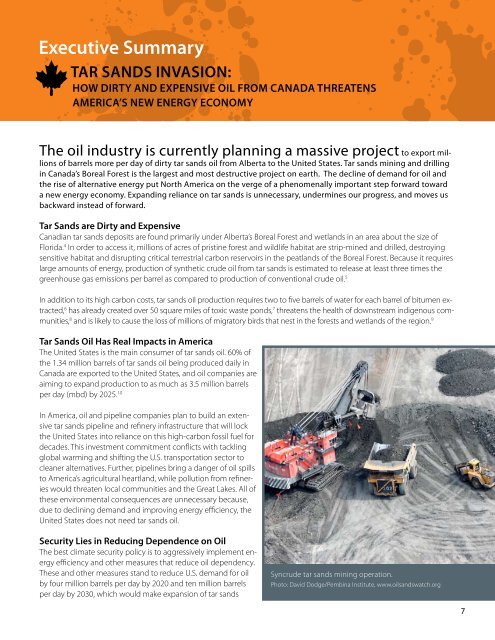l66nu8g
l66nu8g
l66nu8g
You also want an ePaper? Increase the reach of your titles
YUMPU automatically turns print PDFs into web optimized ePapers that Google loves.
Executive Summary<br />
Tar Sands invasion:<br />
How Dirty and Expensive Oil from Canada Threatens<br />
America’s New Energy Economy<br />
The oil industry is currently planning a massive project to export millions<br />
of barrels more per day of dirty tar sands oil from Alberta to the United States. Tar sands mining and drilling<br />
in Canada’s Boreal Forest is the largest and most destructive project on earth. The decline of demand for oil and<br />
the rise of alternative energy put North America on the verge of a phenomenally important step forward toward<br />
a new energy economy. Expanding reliance on tar sands is unnecessary, undermines our progress, and moves us<br />
backward instead of forward.<br />
Tar Sands are Dirty and Expensive<br />
Canadian tar sands deposits are found primarily under Alberta’s Boreal Forest and wetlands in an area about the size of<br />
Florida. 4 In order to access it, millions of acres of pristine forest and wildlife habitat are strip-mined and drilled, destroying<br />
sensitive habitat and disrupting critical terrestrial carbon reservoirs in the peatlands of the Boreal Forest. Because it requires<br />
large amounts of energy, production of synthetic crude oil from tar sands is estimated to release at least three times the<br />
greenhouse gas emissions per barrel as compared to production of conventional crude oil. 5<br />
In addition to its high carbon costs, tar sands oil production requires two to five barrels of water for each barrel of bitumen extracted,<br />
6 has already created over 50 square miles of toxic waste ponds, 7 threatens the health of downstream indigenous communities,<br />
8 and is likely to cause the loss of millions of migratory birds that nest in the forests and wetlands of the region. 9<br />
Tar Sands Oil Has Real Impacts in America<br />
The United States is the main consumer of tar sands oil. 60% of<br />
the 1.34 million barrels of tar sands oil being produced daily in<br />
Canada are exported to the United States, and oil companies are<br />
aiming to expand production to as much as 3.5 million barrels<br />
per day (mbd) by 2025. 10<br />
In America, oil and pipeline companies plan to build an extensive<br />
tar sands pipeline and refinery infrastructure that will lock<br />
the United States into reliance on this high-carbon fossil fuel for<br />
decades. This investment commitment conflicts with tackling<br />
global warming and shifting the U.S. transportation sector to<br />
cleaner alternatives. Further, pipelines bring a danger of oil spills<br />
to America’s agricultural heartland, while pollution from refineries<br />
would threaten local communities and the Great Lakes. All of<br />
these environmental consequences are unnecessary because,<br />
due to declining demand and improving energy efficiency, the<br />
United States does not need tar sands oil.<br />
Security Lies in Reducing Dependence on Oil<br />
The best climate security policy is to aggressively implement energy<br />
efficiency and other measures that reduce oil dependency.<br />
These and other measures stand to reduce U.S. demand for oil<br />
by four million barrels per day by 2020 and ten million barrels<br />
per day by 2030, which would make expansion of tar sands<br />
Syncrude tar sands mining operation.<br />
Photo: David Dodge/Pembina Institute, www.oilsandswatch.org<br />
7


